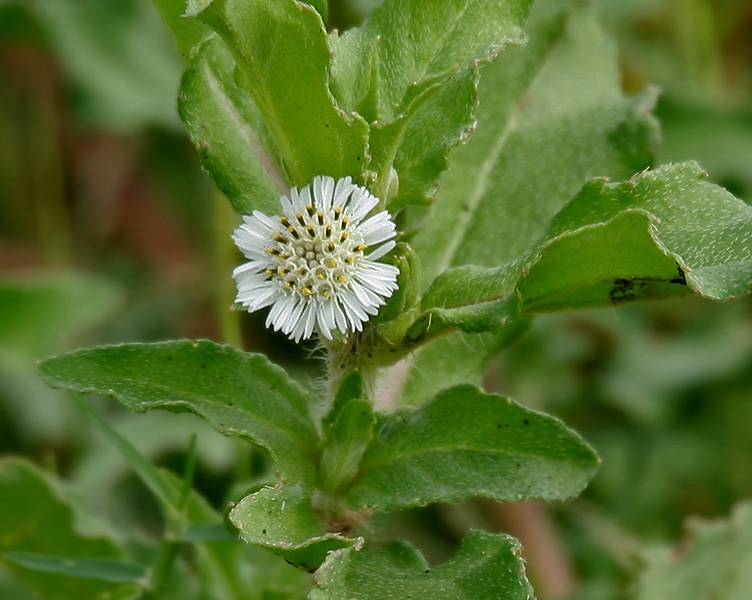
Bhringaraj, scientifically known as Eclipta alba (L.), is a highly valued medicinal herb commonly known as false daisy or karisalankanni. Belonging to the Asteraceae family, this annual herbaceous plant is distributed widely across India, China, Thailand, and Brazil. It typically grows as a weed in waste places, marshy lands, hedges, and roadsides, thriving particularly well in tropical regions. In India, Bhringaraj is primarily found in the states of Assam, Bihar, Uttar Pradesh, and Manipur.
Medicinal Significance
-
Bhringaraj is renowned in Ayurvedic medicine, where it is a key ingredient in numerous herbal formulations.
-
The herb is celebrated for its bitter, hot, sharp, and dry taste, making it effective in treating vitiated conditions of kapha and vata.
-
It is considered the best remedy for liver disorders, including cirrhosis and hepatitis, and is a primary component in hepatoprotective formulations. Additionally, Bhringaraj is extensively used in hair care products like shampoos, conditioners, and revitalizing oils, earning it the title "The King of Hair."
-
Its chemical composition, rich in alkaloids and flavonoids, underpins its diverse pharmacological properties.
Soil and Climate Requirements
-
Bhringaraj is a resilient crop that can grow in various soil types, though it prefers soils with high moisture content.
-
Red loamy soils enriched with organic matter are ideal for its cultivation.
-
The crop flourishes in tropical, subtropical, and temperate regions, with an optimal temperature range of 25-35°C promoting maximum growth and yield.
Propagation Techniques
Bhringaraj can be propagated either through seeds or stem cuttings.
-
For seed propagation, use 400-500 grams per hectare.
-
Vegetative propagation involves using terminal cuttings of 10-15 cm length with 5-6 nodes, planted in nursery beds or polythene bags. These cuttings establish roots within 4-6 weeks, after which they can be transplanted to the main field.
Cultivation Method
-
Proper land preparation is crucial for Bhringaraj cultivation. The field should be ploughed and harrowed multiple times to achieve a fine tilth.
-
Ensuring the field is well-leveled and has efficient drainage systems is essential to prevent waterlogging, especially during the rainy season.
-
Dividing the field into manageable sub-plots facilitates easier cultivation and maintenance.
-
The soil should be prepared to a depth of 30 cm and enriched with farmyard manure (FYM) at 2 kg/m². Fresh seeds have a germination rate of 75-85% and can be transplanted to the main field after 45-60 days.
-
Seeds should be sown in nursery beds of 1x3x0.15 meters in February-March or during the rainy season.
-
Seedlings or rooted cuttings should be transplanted into the main field with a spacing of 20 x 20 cm. Light irrigation should be provided immediately after planting to ensure the plants establish well.
-
After transplanting, irrigate twice a week for the first month to ensure the plants establish well. Subsequently, water the plants weekly, depending on rainfall and soil moisture content.
-
The first weeding should be done 30-35 days after transplanting, with subsequent weedings as necessary. After the first harvest, weeding helps control weed growth in the interspaces.
Manures and Fertilizers
-
Optimal growth and yield in Bhringaraj can be achieved by applying fertilizers at the rate of 30:40:20 NPK kg/ha and well-rotted farmyard manure at 15 t/ha.
-
Half the nitrogen and the full doses of phosphorus and potassium should be applied at transplanting, with the remaining nitrogen applied in two splits after the first and second cuttings.
Pest and Disease Management
Bhringaraj is generally resilient to pests. However, it may occasionally be affected by defoliating insects and diseases like yellowing, leaf blight, and gall formation. These can be effectively controlled by spraying 0.2% mancozeb.
Harvesting and Yield
-
Harvest Bhringaraj 90 days after transplanting by cutting the above-ground portion, leaving 10-12 cm for ratoon cropping.
-
The harvested parts should be cleaned, shade-dried, packed in gunny bags, and stored in a cool, dry place to prevent fungal infections.
-
The average fresh herbage yield is about 8 t/ha for the first cropping and 3 t/ha from the ratoon crop.
Economic Aspects
-
Bhringaraj can produce approximately 11-12 t/ha of fresh herbage annually.
-
After drying, which reduces moisture content by 60%, the yield is about 6000 kg of dried herbage per hectare per year.
-
The estimated cultivation cost is around Rs. 20,000 per hectare.
-
With a prevailing selling price of Rs. 25/kg for dry herb, a gross return of Rs. 150,000 per hectare can be achieved, resulting in a net return of Rs. 130,000 per hectare.
(Source: K. Hima Bindu and M.R. Rohini, ICAR-Indian Institute of Horticultural Research, Banglore)
















